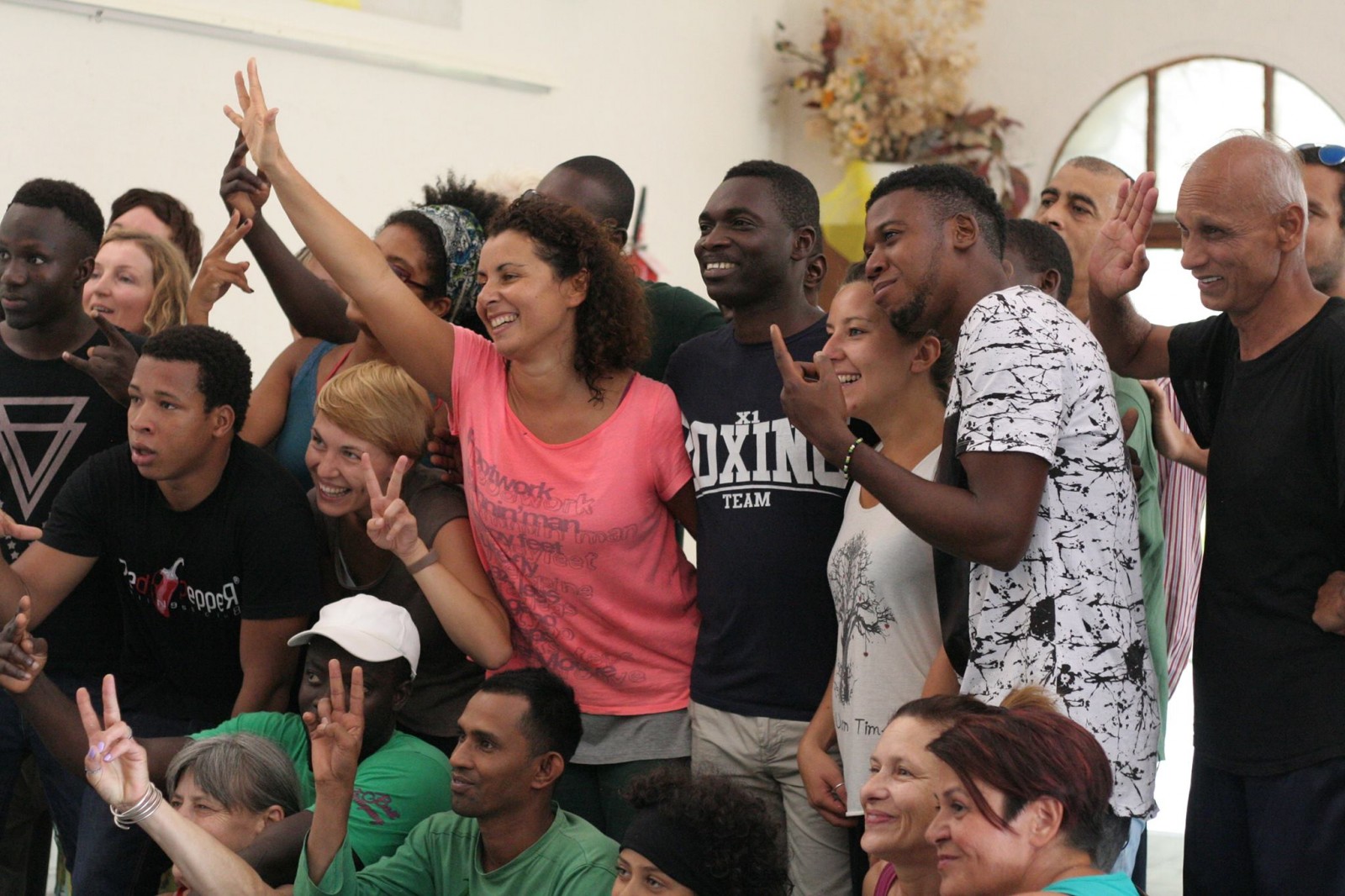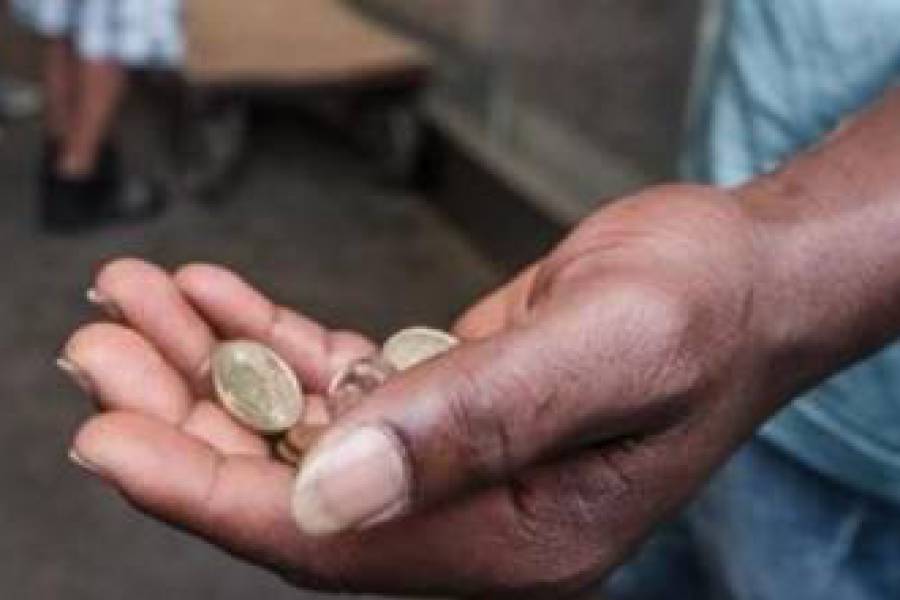
Li chiamo semplicemente così: LABORATORI MULTICULTURALI perchè quando ho davanti questi corpi spenti, chiusi, timidi, l’arma più potente oltre al mio sorriso è l’Hip Hop. Non una danza, non un genere musicale, ma un’espressione artistica e sociale che nasce storicamente da un disagio, nelle fasce emarginate, con un grande desiderio di rivalsa e che si rivela potente, immediata, attuale, in continua trasformazione e divenire, che promette in qualche modo un nuovo status.
“Albert Murray calls the African American public dance a rytual of purification, affirmation, and celebration. It helps drive the blues away and provides to rich opportunities to symbolically challenge societal hierarchies by offering powers and freedom that are impossible in ordinary life. AT A DANCE, ANYONE WITH THE RIGHT MOVES MAY BECOME KING OR QUEEN OF THE FLOOR” Steppin’on the blues – J.Malone

Il pensiero di uno dei partecipanti a fine lezione. Laboratorio tenuto a Genova per la cooperativa Ce.Sto
Sono LABORATORI MULTICULTURALI perchè mi ritrovo a cominciare la frase in francese, continuo in inglese, metto quelle due parole di djoulà, wolof, bambara che so…contiamo in coro i passi in italiano, quando si suda mi insegnano a dire caldo in kurdo…spiego un ritmo col body percussion e i loro occhi si illuminano raccontandomi della loro danza tradizionale in cui battono le mani, in Afghanistan, l’Attan…
io insegno
io imparo
semplicemente scambiamo. Conoscenze. Sorrisi. Circolano nuove energie. E un pò di speranza
Certamente non posso aiutarli ad ottenere dei documenti. Non posso insegnar loro un mestiere. Ma a volte gli operatori mi hanno confessato che alcuni di loro non avevano mai sorriso dal loro arrivo, che vederli danzare divertiti è stato una specie di miracolo. Posso restituire loro la voglia di lottare, di sperare, di costruire, perchè la danza e la musica sono un’arma potentissima.
“Non dovremmo usare più per loro la parola clandestini: inganna, svia, dovremmo restaurare l’antica cara nostra parola di migranti. Perchè non è soltanto e soprattutto la miseria che li muove (…) E’altro che li spinge, una forza che sempre ha mosso i giovani a muoversi, a cambiare, a sognare, cercano un’altra vita e basta, vogliono sognare e provare” Esodo – D.Quirico
Sono LABORATORI MULTICULTURALI perchè ogni incontro è un viaggio intorno al mondo : Ghana, Gambia, Mali, Guinea, Bangladesh, Pakistan, Afghanistan, Nigeria..ma anche Italia, Francia, Olanda, Germania perchè sono davvero aperti a tutti, per origine ed età!
Chi é arrivato da poco giocandosi tutto, chi vive qui da 30 anni sentendosi ancora lo “straniero”, chi non si é mai realmente messo in viaggio e chi con la testa vive altrove sempre.
Gioia pura, sorrisi enormi..si muove tantissimo e non solo i nostri corpi!
“Abitanti di un mondo in declino, trepidiamo soltanto la nostra ricchezza, proprio come i popoli vecchi, le civiltà al tramonto. E non ci accorgiamo che nelle nostre tiepide città, in cui coltiviamo la nostra artificiale solitudine, vi sono già alveari ronzanti, di rumore e di colore, di preghiera e furore. Il mondo di domani” Esodo – D.Quirico
Nelle Jam Hip Hop, comunemente si finisce a fare Soul Train. Un momento di festa e aggregazione che fa riferimento ad una trasmissione storica degli anni ’60-70, che lanciava cantanti (che avrebbero in seguito fatto la storia del Soul, del Funk, dell’Hip Hop come James Brown, The Temptations, Kool & the Gang etc ) e che dava la possibilità a ballerini non professionisti di avere un momento di notorietà. Una trasmissione di successo in un periodo fertile in cui si è posata una pietra miliare nella storia della social dance.
Propongo un Soul Train anche all’interno di questi laboratori. Ma quando mi ritrovo a spiegar loro da dove nasce e perchè, mi rendo conto che la loro traduzione letterale ha molto più senso : è davvero un “Treno di Anime”. Loro sono qui in transito, un viaggio non ancora giunto a termine. Destini sospesi, che hanno posato piede in una terra sicura, senza guerra, ma che fino al raggiungimento di un benedetto pezzo di carta, sono sospesi in un’attesa snervante, spesso passata a fare niente, solo ad aspettare. Spiego loro che devono trovare il modo di attraversare quel corridoio sperimentando il passo più personale e stiloso, perchè agli altri venga voglia di imitarli, per essere ricordati, per essere di ispirazione ed esempio. Si illuminano, questa pratica la conoscono bene, lo hanno già fatto in tutti i numerosi viaggi che tappa dopo tappa li hanno portati qui.
Da oggi per me Soul Train ha un nuovo significato. Bellissimo e commuovente.
“E’ l’attesa l’essenza del clandestino, il suo spirito vitale (…) Il clandestino è un uomo che aspetta. Non un uomo che ha paura, che prega, che sogna, che magari accumula rabbia. Attende di avere la cifra per potersi pagare il viaggio, attende il mediatore che ha il compito di organizzarlo, il passeur con il prezzo giusto. Attende anche la nave che , forse, non affonderà, il mare buono, il momento in cui il carico umano è completo e il viaggio rende, il capitano che ha fama di conoscere l’abbecedario dei venti e delle maree, il momento in cui la polizia è ancor più distratta del solito. Aspetta. Un giorno, una settimana, un mese. La sua è una dimensione complessa del presente, aspirato dal passato e proteso al futuro. L’attesa è la sua seconda pelle, la indossa, se ne avvolge, la usa per difendersi. Resta sospeso inun tempo dove le lancette dell’orologio antico si sono definitivamente fermate, non valgono più , ma quelle nuove sono anora senza carica, immobili. Aspettare, senza pensare, senza fare previsioni di come andrà, tenendo a bada le speranze.”Domenico Quirico – Esodo
 That’s how I call them: MULTICULTURAL WORKSHOPS because when I see these lifeless, shut-down, shy bodies, the most powerful weapon I have, besides my smile, is Hip Hop.
That’s how I call them: MULTICULTURAL WORKSHOPS because when I see these lifeless, shut-down, shy bodies, the most powerful weapon I have, besides my smile, is Hip Hop.
Not a dance, not a music genre, but rather an artistic and social expression that historically originates from distress, among marginalized groups, with a strong desire for redemption – powerful, immediate, relevant, constantly transforming and developing, somehow promising a new status.
“Albert Murray calls the African American public dance a rytual of purification, affirmation, and celebration. It helps drive the blues away and provides to rich opportunities to symbolically challenge societal hierarchies by offering powers and freedom that are impossible in ordinary life. AT A DANCE, ANYONE WITH THE RIGHT MOVES MAY BECOME KING OR QUEEN OF THE FLOOR” Steppin’on the blues – J.Malone

A comment by one of the boys at the end of the lesson. Workshop held in Genoa for the Ce.Sto Cooperative
They are MULTICULTURAL WORKSHOPS because I find myself starting a sentence in French, continuing in English, adding a couple of words in Djoulà, Wolof, Bambara…we count the steps together in Italian, when we’re sweating they teach me how to say “hot” in Kurdo… I describe a particular rhythm through body percussion and their eyes brighten up when they tell me about Attan, a traditional Afghan dance in which they clap their hands…
I teach
I learn
Simply, we share. Getting to know people. Smiles. New energies flow around. And a bit of hope, too.
Sure, I can’t help them get their VISA’s. I can’t teach them a trade.
But sometimes the staff confessed that some of them had never even smiled since the day of their arrival and that seeing them dancing and having fun looked like some kind of miracle. I can give them back their will to fight, to hope, to build something, because dance and music are an extremely powerful weapon.
“We shouldn’t refer to them as clandestini (illegal immigrants): it’s misleading, deceitful, we should reintroduce our good old word migranti (migrants). Because poverty is not the main and only reason behind their being on the move (…) There’s something else pushing them, a power that has always pushed young ones to move, to change, to dream – they are only looking for a new life, they want to dream and try” Esodo – D.Quirico
They are MULTICULTURAL WORKSHOPS because every class is a trip around the world: Ghana, Gambia, Mali, Guinea, Bangladesh, Pakistan, Afghanistan, Nigeria…but also Italy, France, the Netherlands, Germany because they’re really open to everyone, no matter their nationality or their age! Someone has arrived here recently putting everything on the line, someone has lived here for 30 years and still feels like a “foreigner”, someone never really left and someone keeps living elsewhere in their own mind.
“Citizens of a world in decline, wealth is the only thing we are anxious about, just like old peoples, collapsing civilizations. And we do not even realize that in our lukewarm cities, where we cultivate our artificial loneliness, there are already hives that buzz with noise and color, with plea and rage. The world of tomorrow.” Esodo – D. Quirico
During Hip Hop Jams, people usually end up doing Soul Train. A moment of celebration and aggregation with reference to a historic 60s-70s TV show that started many singers on their career (singers who would later make the history of Soul, Funk, Hip Hop, like James Brown, The Temptations, Kool & the Gang etc.) and that gave non-professional dancers the chance to have their 15 minutes of fame. A successful broadcast in a fertile period, when a milestone of social dance history was set.
I suggest we do a Soul Train also during these workshops. But when I explain to them where it comes from and why, I realize that their literal translation makes much more sense – it actually is a Treno di Anime (Train of Souls). They are here in transit, a journey that hasn’t come to an end yet. Pending fates. They set foot in a safe country, without war, but until the moment when they finally obtain a piece of paper they are hanging, enduring a nerve-racking wait, often with nothing to do, except waiting. I tell them that they have to find a way to dance down that aisle experimenting, doing their more personal and stylish move, to make the rest of the group want to imitate them, to be remembered, to inspire people and be an example for them. They brighten up, they know this practice very well, they have already done this throughout all of the journeys that, one stage after another, brought them here.
From now on, Soul Train has a whole new meaning to me. Beautiful and moving.
“The wait is the very essence of the illegal immigrants, their life spirit (…) The illegal immigrant is someone who waits. Not someone who is afraid, who prays, who dreams, who maybe lets anger build up inside them. They wait until they have reached the amount of money they need to pay for their journey, they wait for the mediator who will plan it, for the smuggler who offers the right price. They also wait for the ship that, hopefully, won’t sink, for the calm sea, for the moment when the human cargo is large enough for the journey to be profitable, for the captain who is known for being a master of tides and winds, the moment when policemen are less attentive than usual. They wait. One day, one week, one month. Their conception of present is complex, it is pulled back by their past and it reaches out towards the future. The wait is their second skin, they wear it, they wrap themselves in it, they use it to protect themselves. They are left hanging in a time where the hands of the old clock stopped permanently, they don’t matter anymore, but the new ones are still out of power, motionless. Waiting, without thinking, without predicting how it is going to work out, keeping their hopes down. – Esodo



